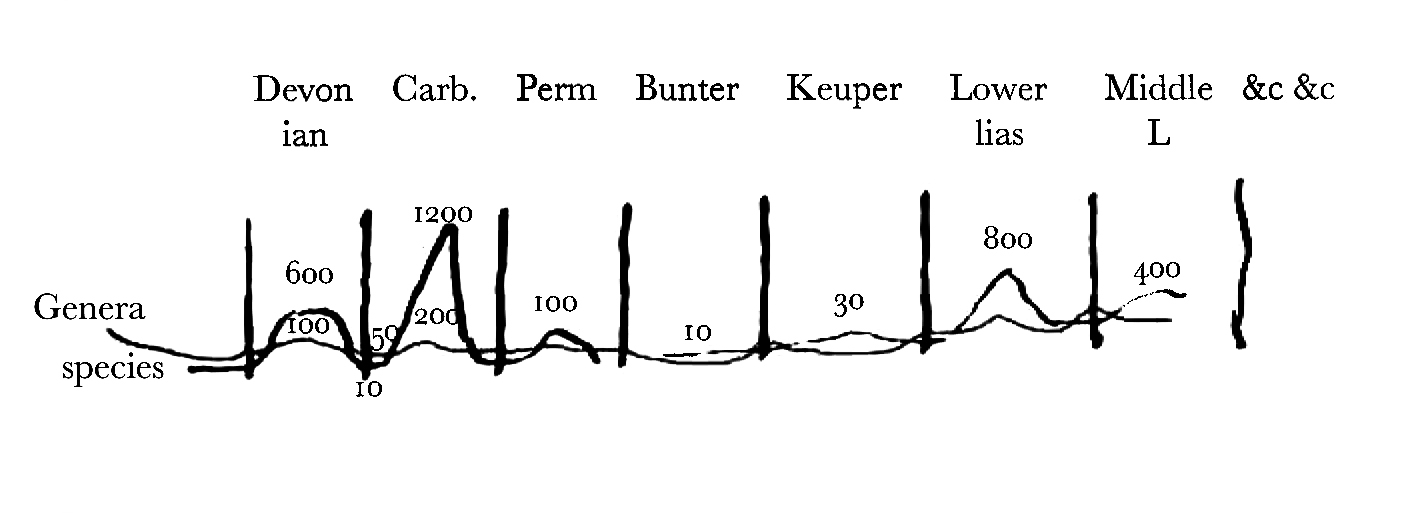From A. C. Ramsay 6 May 1863
DolauCothy, Llandielo
6 May 1863
My dear Sir
Having nothing to do I am so lazy that I have neglected for some days to answer your welcome letter.1 In truth I have been here now 4 weeks trying to coax myself by idleness into my usual health. I have I hope partially succeeded but not thoroughly as yet. The prescription is however pleasant, viz a lovely place, old & well beloved friends a good library including plenty of novels, some pretty girls, my wife & one of my daughters,2 good trout streams and a horse to ride on when I want it.
I am very glad that you approve of my address.3 I supposed that if properly treated the subject would be sure to interest you both as a geologist & a Zoologist. Sir Charles Lyell writes me that he hopes I will continue the subject precisely as I began it if I continue President.4 Such was my intention with possible additions in the summing up. Sir Charles wishes that experienced Surveyors all over the Continent would each do the same for their own Countries, but from what I have seen of Continental Surveys the mapping has not been done in sufficient detail to admit of it. Sella who reported to the Italian government on the Subject said to me that all the Continental surveys were done too rapidly.5 For years I have had a diagram which I used in my lectures,6 something like one that you suggest, but with a considerable difference, & I thought of using it in my next address if I can find time to correct it up to date.7
It is like this8

It shows the number of species in each formation, the number of genera, & also the number of genera & species that pass from one formation to another, & is very instructive.
Logan has a splendid Case in Canada of a cliff overlapped in the way you mention.9 All the rocks concerned in the question are Old Silurian &c. I have no doubt he will send you a copy of the book when published.10 I know of no positive case in England, but we have something like it too. “Creeps” are certainly often over the land.
You do me too much honour in supposing that I can give a satisfactory philosophical discussion on these & the other points you mention, but it must be done some day, & if I live & thrive perhaps I may try my hand at it.
Have you seen Geikie’s new book on the Drift of Scotland?11 It seems excellent.
This South Welsh land is full of Scratched stones & boulders. When I mapped it 20 years ago I knew the erratics when I saw them but I had then never seen a glacier & was not up to the Scratched stones.12 There is a good field here still remaining for any one to work out in that way. For want of clear sections I cannot say whether the detritus is all or mostly iceberg work, or whether land ice did a deal of it. There are no mountains here, but all the country is hilly.
Ever sincly | Andrew C Ramsay
Footnotes
Bibliography
Correspondence: The correspondence of Charles Darwin. Edited by Frederick Burkhardt et al. 29 vols to date. Cambridge: Cambridge University Press. 1985–.
County families: The county families of the United Kingdom; or, royal manual of the titled & untitled aristocracy of Great Britain & Ireland. By Edward Walford. London: Robert Hardwicke; Chatto & Windus. 1860–93. Walford’s county families of the United Kingdom or royal manual of the titled and untitled aristocracy of England, Wales, Scotland, and Ireland. London: Chatto & Windus; Spottiswoode & Co. 1894–1920.
DNB: Dictionary of national biography. Edited by Leslie Stephen and Sidney Lee. 63 vols. and 2 supplements (6 vols.). London: Smith, Elder & Co. 1885–1912. Dictionary of national biography 1912–90. Edited by H. W. C. Davis et al. 9 vols. London: Oxford University Press. 1927–96.
Geikie, Archibald. 1863. On the phenomena of the glacial drift of Scotland. Glasgow: John Gray.
Geikie, Archibald. 1895. Memoir of Sir Andrew Crombie Ramsay. London and New York: Macmillan.
[Logan, William Edmund.] 1863. Geological Survey of Canada. Report of progress from its commencement to 1863. Montreal, Quebec: Dawson Brothers. London: Baillière.
Ramsay, Andrew Crombie. 1855. On the occurrence of angular, subangular, polished, and striated fragments and boulders in the Permian Breccia of Shropshire, Worcestershire, &c.; and on the probable existence of glaciers and icebergs in the Permian epoch. [Read 21 February 1855.] Quarterly Journal of the Geological Society of London 11: 185–205.
Sarjeant, William A. S. 1980–96. Geologists and the history of geology: an international bibliography. 10 vols. including supplements. London: Macmillan. Malabar, Fla.: Robert E. Krieger Publishing.
Summary
Glad CD likes his Presidential Address to Geological Society [1863].
Will continue the practice [of discussing the break in succession of strata].
Has devised a diagram showing number of genera and species in each geological formation and the number that pass from formation to formation.
Describes the glaciated terrain of S. Wales.
Letter details
- Letter no.
- DCP-LETT-4143
- From
- Andrew Crombie Ramsay
- To
- Charles Robert Darwin
- Sent from
- Dolaucothy
- Source of text
- DAR 176: 11
- Physical description
- ALS 8pp
Please cite as
Darwin Correspondence Project, “Letter no. 4143,” accessed on 26 May 2024, https://www.darwinproject.ac.uk/letter/?docId=letters/DCP-LETT-4143.xml
Also published in The Correspondence of Charles Darwin, vol. 11


